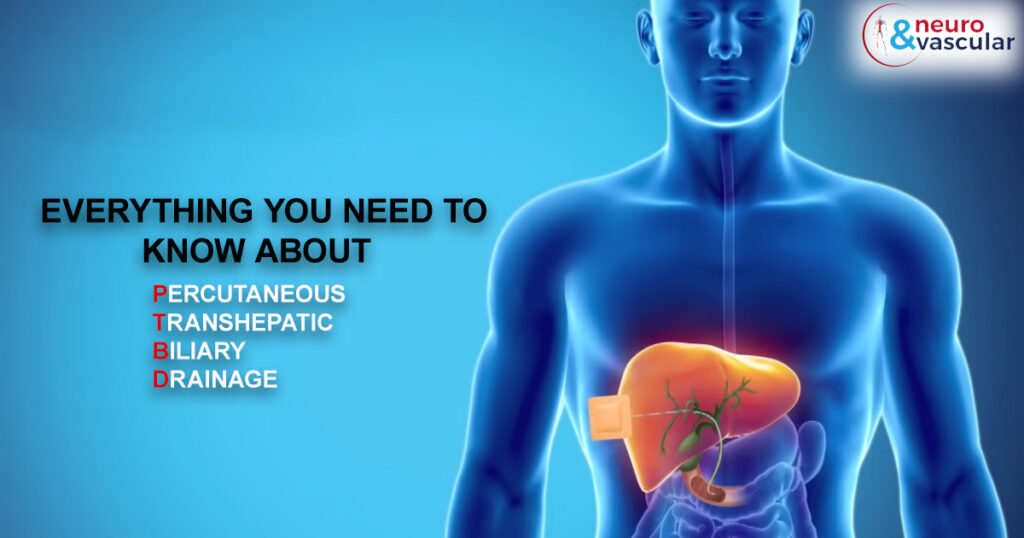
Percutaneous Transhepatic Biliary Drainage(PTBD)

A Normally functioning digestive system is responsible for breaking down and absorbing nutrients into your bloodstream. The liver produces bile salts that help in the breakdown of the fats entering the small intestine. When your bile ducts have blockages from cancer or any other benign cause, the bile salts build up in the liver and blood. Then people may experience yellowing eyes and skin, dark urine and pale stools. Sometimes pain in the abdomen and fever or accumulation of fluids may happen in the abdomen. This is a severe condition if the blockage is not corrected, it can lead to life-threatening infection or even liver damage. One way to remove or clear the bile blockage is to perform a PTBD procedure by an Interventional Radiologist.
What is PTBD Procedure?
Percutaneous Transhepatic Biliary Drainage (PTBD) is a minimally-invasive procedure for the treatment of a bile duct obstruction. The objective of the procedure is to locate the obstruction and/or to insert a temporary catheter to drain the bile or sometimes to insert a stent in the bile duct for a permanent cure. It is done in patients who are having a blockage in the bile duct due to cancer or stone where endoscopic drainage is not possible or in failed ERCP.
What causes blockage of the bile ducts?
There are several conditions that may cause this including:
- Gallstones (stones in the gallbladder or inside the bile ducts)
- Tumors of the bile ducts, liver, pancreas or gallbladder
- Pancreatitis (inflammation of the pancreas)
- Expanded lymph nodes in the region of the liver and pancreas
- Postoperative strictures
- Infection
What are the symptoms of obstruction of bile ducts?
Symptoms may include:
- Abdominal pain in the upper right side
- Dark urine
- Fever
- Itching
- Jaundice (yellow skin color)
- Nausea and vomiting
- Pale-colored stools
Diagnosis:
The following tests may be used to investigate a possible blocked bile duct:
- Abdominal ultrasound
- Abdominal CT scan
- Magnetic resonance cholangiopancreatography (MRCP)
- Endoscopic ultrasound (EUS)
How is PTBD Procedure Performed?
The Percutaneous Transhepatic Biliary Drainage (PTBD) Treatment Procedure is performed by an Interventional Radiologist under sterile conditions. A local anesthetic is injected into the skin of the upper abdomen where the catheter will be inserted. A fine needle is then inserted under ultrasound and fluoroscopic direction into the bile ducts in the liver. X-ray dye (contrast agent) will be injected to confirm successful entry into the duct system. A fine guide wire and catheter are then controlled under fluoroscopic guidance, past the obstruction to entering the duodenum. A biliary drainage catheter is then passed over this wire, to stretch out from the duodenum, up through the bile ducts, liver, and onto the skin. This will then be secured to the skin at the puncture site and connected to a drainage bag to collect the bile which drains out of the liver through this catheter. Sometimes if no further plan of surgery is there, a self-expanding metal stent is placed across the block with no or minimally need for an external catheter. After the procedure, the patient is kept under observation for some time. Once stable, the patient can be discharged with appropriate instructions and follow-up.
Benefits of PTBD:
• Minimally invasive procedure.
• No general anesthesia is required.
• The catheter will relieve the obstruction to the flow of bile from the liver to the small intestine. In doing so, infection and pain from the obstruction will be reduced and liver function is preserved.
• Often an endoscopic relief of the obstruction is not possible and a PTBD is the only means of relieving the obstruction.
Risks and Complications of PTDB:
- Intra-abdominal bleeding; bleeding in the bile duct.
- Infection of the skin where the catheter is inserted and infection in the bile duct.
- Catheter dislodgement.
- Bile leakage.
These complications can be seen in about 5% of cases
Frequently Asked Questions:
Q: Who is an ideal candidate for PTDB?
A: If Patients are unsuitable for endoscopic procedures, PTBD is a possible alternative for them. It can be used to decompress the biliary ducts if they are blocked by a mass lesion or a stone or to bridge a hole if they experience bile leakage.
Q: How long do biliary drains stay in?
A: If a self-expanding metal stent is placed across the block in the bile duct, the external drain may be required for a week. If PTBD is for drainage purposes only, you may need to keep an external drain for an extended period of time (typically four to six weeks), so it will be important for you to understand how to care for the drain properly. This tube will need to be exchanged every three months.
Q: Who is not a candidate for PTBD?
A: Patients who have following symptoms are not good candidates for PTDB Procedure
- Ascites
- Multiple liver obstruction
- Bleeding disorders
About the Author:

Name: DR . SURESH GIRAGANI
INTERVENTIONAL RADIOLOGIST
DR. SURESH GIRAGANI CONSULTANT INTERVENTIONAL RADIOLOGIST at Apollo hospitals Jubilee Hills has more than sixteen years of clinical experience in vascular interventions with a special interest in neurovascular and peripheral vascular disease interventional procedures.